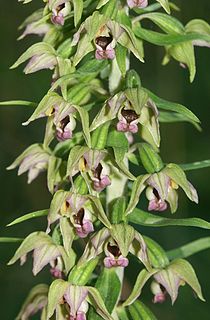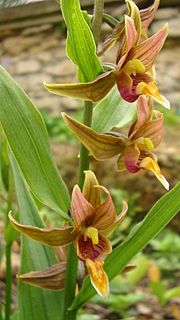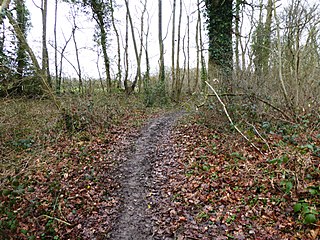
Epipactis, or Helleborine, is a genus of terrestrial orchids consisting of approximately 70 species. This genus is abbreviated as Epcts in horticultural trade.

Cephalanthera rubra, known as red helleborine, is an orchid found in Europe, North Africa and southwest Asia. Although reasonably common in parts of its range, this Cephalanthera has always been one of the rarest orchids in Britain.
Shelleyan Orphan were a British alternative music group that peaked during the 1980s and early 1990s.

Epipactis leptochila, the narrow-lipped helleborine, is a species of orchid in the genus Epipactis. Found in chalk or limestone-based beech and hornbeam woodland in southern England, the orchids are also found with birch and alder trees in Scotland and the north of England. The narrow-lipped helleborine blooms from early June to mid-August. Epipactis leptochila is also found in parts of northern Europe but it is known for its presence in England. Due to woodland clearing, the orchids are becoming less common.

Cephalanthera, abbreviated Ceph in horticultural trade, is a genus of mostly terrestrial orchids. Members of this genus have rhizomes rather than tubers. About 15 species are currently recognized, most of them native to Europe and Asia. The only species found in the wild in North America is Cephalanthera austiniae, the phantom orchid or snow orchid. Ecologically, this species is partially myco-heterotrophic. Some of the Eurasian species hybridise.

Cephalanthera longifolia, known by the common names narrow-leaved helleborine or sword-leaved helleborine or long-leaved helleborine, is a herbaceous perennial plant with rhizomes of the family Orchidaceae. It is native to light woodland, widespread across Europe, Asia and North Africa from Ireland and Morocco to China. This includes Iran, Russia, Kazakhstan, Turkey, Algeria, India, Pakistan, Germany, Italy, France, Spain, Portugal and many other countries.

Epipactis atrorubens, the dark-red helleborine or royal helleborine, is an herbaceous plant in the orchid family, Orchidaceae.
Burderop Wood is a 48.5 hectare biological Site of Special Scientific Interest in Wiltshire, notified in 1971.9pp

Postlebury Wood is an 87 hectare biological Site of Special Scientific Interest south of Trudoxhill in Somerset, notified in 1987.

Galley Down Wood is a 16.6-hectare (41-acre) biological Site of Special Scientific Interest north-east of Bishop's Waltham in Hampshire.

Epipactis helleborine, the broad-leaved helleborine, is a terrestrial species of orchid with a broad distribution. Its nodding flowers vary from greenish pink to purple. It prefers shaded woodland environments.

Epipactis palustris, the marsh helleborine, is a species of orchid native to Europe and Asia.
Epipactis helleborine var. youngiana, known as Young's helleborine, is a variety of orchid that is endemic to Great Britain. It has also been treated as a separate species, Epipactis youngiana.

Epipactis gigantea is a species of orchid known as the stream orchid, giant helleborine, and chatterbox. This wildflower is native to western North America from British Columbia to central Mexico. This is one of the most abundant orchids of the Pacific coast of North America.

The white helleborine is a species of orchid. It is widespread across much of Europe, the Middle East and Asia. Cephalanthera damasonium is the type species of the genus Cephalanthera.

Grangelands and Pulpit Hill is a 25.5 hectare biological Site of Special Scientific Interest in Cadsden in Buckinghamshire. It lies within the Chilterns Area of Outstanding Natural Beauty, and the planning authorities are Wycombe District Council and Buckinghamshire County Council.

Tring Woodlands is a 23.8 hectare biological Site of Special Scientific Interest in Tring in Hertfordshire. It is part of the Chilterns Area of Outstanding Natural Beauty and the local planning authority is Dacorum District Council. The wood has a rich flora, showing that it is well established. It is a good example of a semi-natural beech wood in Hertfordshire. Plants that are abundant include woodruff, wood anemone and dog's mercury, and there are a variety of woodland birds. There is access to the wood from Hastoe Hill.

Parsonage Wood is a 9.7-hectare (24-acre) biological Site of Special Scientific Interest south-east of Cranbrook in Kent. It is owned and managed by the Kent Wildlife Trust.

Wallis Wood is a 14-hectare (35-acre) nature reserve south-east of Ewhurst in Surrey. It is managed by the Surrey Wildlife Trust.

Harpsden Wood is a 29.4-hectare (73-acre) biological Site of Special Scientific Interest south of Henley-on-Thames in Oxfordshire. It is owned by the Woodland Trust and is open to the public.
















